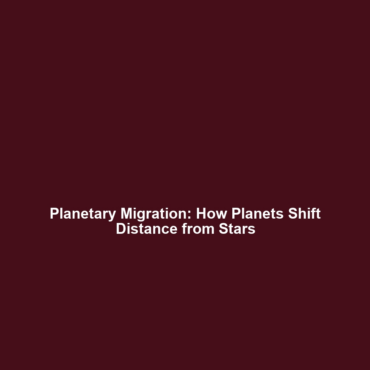Planetary Migration: How Planets Move Closer or Farther from Their Stars after Formation
Introduction
Planetary migration is a crucial phenomenon in astrophysics, particularly significant within the study of exoplanets. This process involves the movement of planets in a solar system either closer to or further from their host star after their initial formation. Understanding planetary migration helps astronomers to elucidate the diversity of planetary systems observed beyond our own and offers insights into their formation and evolution. With the discovery of various exoplanets exhibiting unexpected characteristics, understanding how planetary migration influences these heavenly bodies is essential for advancing this field.
Key Concepts
Several fundamental principles elucidate the mechanisms behind planetary migration:
- Type I Migration: Occurs in protoplanetary disks, where planets exert gravitational forces that can lead to their inward movement.
- Type II Migration: Involves larger planets which can clear out paths in the disk, subsequently moving closer to the star as disk material is lost.
- Resonance Migration: Planets can influence each other’s orbits through gravitational interactions, potentially leading to migration.
These concepts are pivotal in studying the characteristics and distributions of exoplanets in various solar systems.
Applications and Real-World Uses
The study of planetary migration holds significant implications within the field of exoplanets:
- Reconstructing Planetary Histories: By understanding planetary migration, scientists can better track the history and evolution of exoplanetary systems.
- Predicting Habitability: The migration patterns can reveal which exoplanets may have moved into habitable zones.
- Modeling Exoplanetary Systems: Simulation models can benefit from incorporating orbital migration techniques to predict the configurations of distant planetary systems.
Current Challenges
However, certain challenges persist regarding the study of planetary migration:
- Inconsistent Observational Data: Limited observational data on distant planetary systems hampers understanding of migration dynamics.
- Complex Models: Theoretical models are often complex and require simplifications that may overlook critical factors.
- Limited Technology: Current technology may not be able to capture the intricacies of planetary interactions in real-time.
Future Research and Innovations
Looking ahead, advancements in technology and research methodologies are expected to enhance our understanding of planetary migration. Areas of focus include:
- High-Resolution Imagination: Next-generation telescopes may provide clearer observational data of exoplanet systems.
- Machine Learning Models: Utilizing machine learning to analyze vast datasets could unveil patterns in planetary dynamics.
- Laboratory Simulations: Improved experimental setups can mimic the conditions seen in protoplanetary disks, leading to better understanding of migration mechanics.
Conclusion
In conclusion, planetary migration is a fundamental process that shapes the orbits of exoplanets and has significant implications for understanding their formation and evolution. As research progresses, it is vital to improve observational techniques and theoretical models to further unravel the complexities of planetary dynamics. For more information on related topics, explore our articles on exoplanets and planet formation.


